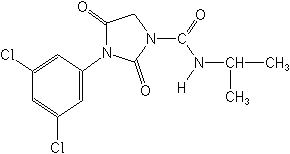Products >> Fungicides >> Iprodione
Iprodione
Iprodione 95%TC
Iprodione 50%SC
Fungicide
FRAC 2; dicarboximide

Iprodione NOMENCLATURE
Common name iprodione (BSI, E-ISO, (m) F-ISO, ANSI)
IUPAC name 3-(3,5-dichlorophenyl)-N-isopropyl-2,4-dioxoimidazolidine-1-carboxamide
Chemical Abstracts name 3-(3,5-dichlorophenyl)-N-(1-methylethyl)-2,4-dioxo-1-imidazolidinecarboxamide
Other names glycophene* (rejected common name proposal) CAS RN [36734-19-7]
EEC no. 253-178-9 Development codes 26 019 RP (
Iprodione APPLICATIONS
Mode of action Contact fungicide with protective and curative action.
Inhibits germination of spores and growth of fungal mycelium. Uses
Control of Botrytis, Monilia, Sclerotinia, Alternaria, Corticium,
Fusarium, Helminthosporium, Phoma, Rhizoctonia, Typhula spp., etc.
Used mainly on sunflowers, cereals, fruit trees, berry fruit, oilseed
rape, rice, cotton, vegetables, and vines as a foliar spray, at
0.5-1.0 kg a.i./ha, and on turf, at 3-12 kg/ha. Can also be used
as a post-harvest dip, as a seed treatment, or as a dip or spray
at planting. Formulation types DP; EC; FS; SC; SU; WG; WP. Selected
tradenames: 'Kidan' (Aventis); 'Rovral' (Aventis); 'Verisan' (Aventis);
'Botrix' (Agrimix)
Iprodione OTHER TRADENAMES
'Dirac' (Aventis); 'Diva' (Aventis); 'Amazzones' (Rocca); 'Rover'
(Vapco); 'Viroval' (Vipesco) mixtures: 'But' (+ bromuconazole) (Aventis);
'Calidan' (+ carbendazim) (Aventis); 'Chipco' (+ fosetyl-aluminium)
(Aventis); 'Compass' (+ thiophanate-methyl) (Aventis); 'Snooker'
(+ thiophanate-methyl) (Aventis); 'Pacha' (+ carbendazim) (Philagro)
ANALYSIS
Product analysis by hplc or glc (CIPAC Handbook, 1995, G, 98-104;
L. Lacroix et al., Anal. Methods Pestic. Plant Growth Regul., 1980,
11, 247). Residues determined by glc with ECD (idem, ibid.; Man.
Pestic. Residue Anal., 1987, I, 6, S8, S19; Anal. Methods Residues
Pestic., 1988, Part I, M1, M12).
MAMMALIAN TOXICOLOGY
Reviews FAO/WHO 74, 76 (see part 2 of the Bibliography). Oral Acute
oral LD50 for rats and mice >2000 mg/kg. Skin and eye Acute percutaneous
LD50 for rats and rabbits >2000 mg/kg. Non-irritating to skin
and eyes (rabbits). Inhalation LC50 (4 h) for rats >5.16 mg/l
air. NOEL (2 y) for rats 150 mg/kg diet; (1 y) for dogs 18 mg/kg
b.w. ADI (JMPR) 0.06 mg/kg b.w. [1995]. Toxicity class WHO (a.i.)
III (Table 5); EPA (formulation) IV
Iprodione ECOTOXICOLOGY
Birds Acute oral LD50 for bobwhite quail >2000, mallard ducks
>10 400 mg/kg. Fish LC50 (96 h) for rainbow trout 4.1, bluegill
sunfish 3.7 mg/l. Daphnia LC50 (48 h) 0.25 mg/l. Algae EC50 (120
h) for Selenastrum capricornutum 1.9 mg/l. Bees Contact LD50 >0.4
mg/bee. Worms LC50 for earthworms >1000 mg/kg soil. Other beneficial
spp. Harmless.
ENVIRONMENTAL FATE
Animals In rats, ruminants and birds, iprodione is rapidly eliminated.
It also undergoes extensive metabolism, by hydrolysis and rearrangement
reactions. Plants Metabolism studies in cereals, fruit, leafy and
oily crops showed that iprodione is the dominant component of the
total residue resulting from foliar application. Soil/Environment
Rapidly metabolised in soil, with formation of CO2. DT50 (lab.)
20-80 d; (field) 20-160 d. Koc 373 to 1551. Rate of degradation
increases with successive treatments, hence accumulation does not
occur.